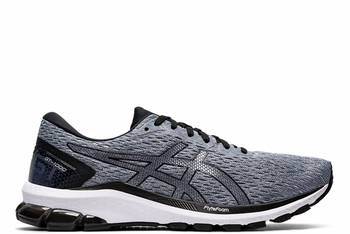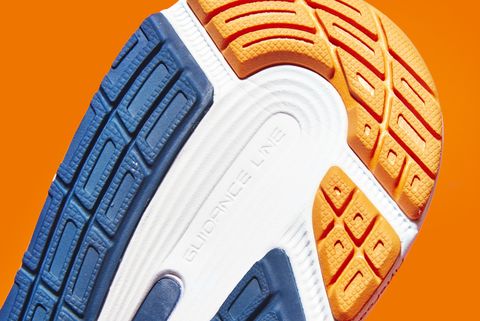
Asics got its start nearly 70 years ago, when Kihachiro Onitsuka began making basketball shoes in his living room in Kobe, Japan. He soon expanded to running shoes, and his first pair, the Marathon Tabi, came out in 1953. His business grew, and in 1977 he merged it with two other companies and began selling footwear in the United States. He also changed the company’s name to Asics, an acronym for the Latin phrase “Anima Sana In Corpore Sano” (a sound mind in a sound body). Since then, Asics has grown into one of the premier running shoe companies.

BEST FOR MARATHON TRAINING
Gel-Cumulus 22

MOST CUSHIONING
Gel-Nimbus 23

MOST AFFORDABLE
GT-1000 9

BEST FOR RACING
Metaracer Tokyo

BEST FOR SPEEDWORK
NovaBlast
A Scientific Approach
In May 1990, Asics opened the Institute of Sports Science in Kobe, where the company conducts materials tests and biomechanical research to fine tune its designs. This lab has produced and refined some of Asics’s hallmark technologies, like its new GuideSole design, as well as one of its best-known innovations: Gel cushioning. It consists of a gel-like substance implanted in the midsole and helps absorb impact forces for a smoother ride. You’ll find it in most of the company’s flagship shoes, including the Gel-Kayano, Gel-Cumulus, and Gel-Nimbus. Another key innovation is the Impact Guidance System, which combines an external heel counter and specially-designed plates in the midsole to provide additional support while running.

Trusstic System
Men’s and women’s stability models each use gender-specific midsole support.

FlyteFoam
The Nimbus Lite uses a lighter, plant-derived iteration of Asics’s responsive foam.

Gel Cushioning
Pockets of gel in the heel and forefoot offer softness and shock-absorption.

Guidance Line
A deep outsole groove runs heel-to-toe for smooth, unobtrusive stability.

AHAR Rubber
High-abrasion outsoles with lateral grooves improve flexibility and traction.
Going Beyond Gel
Like other shoemakers, Asics pushed past EVA foam with its own proprietary cushioning, called FlyteFoam. Formulated to be lighter and more resilient than standard EVA, this material is further refined into subgroups of FlyteFoam Propel—which includes a special elastomer to increase energy return—and FlyteFoam Lyte, an even lighter-weight version. One of the company’s latest developments is GuideSole, which debuted on the MetaRide. It’s a rocker-based sole construction that’s shaped to help runners roll through their stride and reduce ankle movement for more efficient form. In testing, we found that the shoe feels a little stiff and heavy on foot, but the well-cushioned rocker ensures a smooth and controlled ride with a surprising snap and responsiveness.

TREVOR RAAB

TREVOR RAAB
How We Chose These Shoes
Many of the Asics shoes you’ll find below have been through our extensive testing process. That means getting each model on the feet of our team of over 350 avid runners, who then put at least 160 kilometres on the shoe before providing their feedback. As our test team and staff report their on-foot impressions, we also run a battery of mechanical tests on the shoes in our RW Shoe Lab, where we measure everything from the energy return of Asics’s FlyteFoam to the softness of its Gel cushioning. For those options we haven’t personally laced up, we rely on our own in-depth research and experience in the running shoe industry, personal consultation with product engineers, verified online reviews and recommendations, and the data we’ve collected on previous Asics models in our lab.
—BEST FOR RACING—
MetaRacer

Pros
- Carbon-fiber midsole plate improves energy return
- Rocker-style sole promotes a smooth heel-toe transition
Cons
- Some testers wanted softer cushioning for longer distances
The MetaRacer is a culmination of some of the newest technologies Asics has to offer. The big draw here is the GuideSole construction, which uses a rocker sole to help you roll easily onto your toes and improve the efficiency of your stride (at least, that’s what Asics claims). FlyteFoam cushioning absorbs impact forces, and there’s also a carbon-fiber plate tucked into the midsole for added support and an extra jolt of energy return.
—BEST FOR SPEEDWORK—
NovaBlast
Powered by solemotive.com
(Free Aus express shipping on orders over $100)
Pros
- FlightFoam Blast midsole feels springy, comfortable, and lighter
- Engineered mesh upper improves breathability
Cons
- Can feel unstable at times during very tight cornering
Compared to the rest of the Asics lineup, the NovaBlast is a bit radical: It’s a neutral shoe with a thick wedge of lightweight foam (and no support tech) that’s tuned for superb energy return. The midsole uses FlyteFoam Blast, a new foam that creates a soft and exceptionally bouncy ride. Despite the NovaBlast’s tall stack height, the low-density foam keeps the shoe from feeling heavy, and testers loved its springy responsiveness. Although the loose-fitting mesh upper created some stability issues, overall the NovaBlast earned high praise from our testers. “This was probably the fastest shoe I have worn,” said a longtime tester of three dozen models. “The tall heel and bouncy foam felt like a springboard pushing me up on my toes. It performs best in dry conditions, though, as the outsole feels slippery on wet roads.”
—BEST FOR LONG RUNS—
MetaRide

Pros
- Rocker shape promotes a smooth stride
Cons
- Very expensive
Designed to make long-distance running easier, the MetaRide is structured to reduce movement in the ankle joint, where most of your running energy is expended. It does so with Asics’s new design called GuideSole—a rocker-shaped sole that helps you roll forward smoothly through your stride—while layers of FlyteFoam Lyte and FlyteFoam Propel support your feet and provide good energy return. “I did a lot of training for a marathon in this shoe and it ticked all the boxes,” said one tester logging 112 kilometres per week. “My long runs felt effortless, my short runs felt fast, and my hill workouts felt stable. The downside is the shoe’s heavier weight, but that’s made up for by how easy the rocker sole makes the kilometres feel.”
—PLUSHEST STABILITY SHOE—
Gel-Kayano 27
Powered by solemotive.com
(Free Aus express shipping on orders over $100)
Pros
- Upper now uses a more breathable mesh with reflective details
- Deeper outsole flex grooves provide a smoother ride
Cons
- On the heavier side
The Kayano has been a part of the Asics lineup for decades, and it remains one of the company’s most popular shoes. Gel pods in the forefoot and heel, FlyteFoam Propel and FlyteFoam cushioning, and an EVA sock liner all work to absorb impact forces, and a dual-density midsole and medial plate counter overpronation. The latest version features a redesigned mesh upper for better breathability, and updated grooves at the heel and forefoot make the shoe more flexible as well.
—MOST CUSHIONING—
Gel-Nimbus 23
Powered by solemotive.com
(Free Aus express shipping on orders over $100)
Pros
- Softer cushioning and more stable than the Nimbus 22
Cons
- Toe box felt narrow to some testers
Another multi-decade veteran in the Asics lineup, the Gel-Nimbus is a neutral shoe designed for covering long distances. The latest version is tweaked for a more forgiving feel and ride: The upper is made from a softer mesh and the Gel pod in the heel has been tuned to better soak up impact forces. The midsole features a combo of FlyteFoam and bouncy FlyteFoam Propel for good energy return, and new gender-specific medial truss—tuned for the slight differences in gait between male and female runners—offers some additional support.
—BEST FOR MARATHON TRAINING—
Gel-Cumulus 22

Pros
- Smoother ride and more flexible midsole than the Cumulus 21
- Uses new iteration of softer FlyteFoam cushioning
Cons
- Not suited for speedwork
Like the Nimbus, the Cumulus has been in the Asics stable for decades. It’s known for durability and soft cushioning, but the latest version adds a new element to the mix: increased flexibility. The midsole is now composed of FlyteFoam with gel in the heel for a plush feel and good shock absorption, and it comes with deeper grooves in the sole to help you roll through your stride. A new one-piece mesh upper features a 3D-printed construction for an improved fit as well. “I have had success in cushioned shoes like the Brooks Adrenaline and the Hoka Arahi,” said one tester. “But the Cumulus felt lighter while maintaining great cushioning and enough support, even as a neutral model.”
—BEST FOR MILD OVERPRONATION—
GT-2000 9
Powered by solemotive.com
(Free Aus express shipping on orders over $100)
Pros
- Responsive, supportive cushioning
- Slightly lighter than its predecessor
Cons
- Though much smoother than previous versions, it may still feel too stiff for some runners
The GT-2000 makes a good pick for runners who don’t need a ton of support but still want something with a bit more stability than a neutral shoe. FlyteFoam and Gel units at the heel and forefoot deliver reliable cushioning (and a more forgiving ride than earlier versions of the shoe), and a dual-density midsole and guidance plate help control excessive pronation. The ninth version comes with a redesigned one-piece mesh upper for an improved fit, and it’s also reinforced around the arches for extra support. “The best features of this shoe are the fit and comfort of the engineered mesh upper—particularly in the toe box—and the shoe’s overall ride,” said one tester. “I’ve run in several iterations of the GT-2000, and I truly believe that it continues to improve. Transitions from heel strike through toe off are seamless, with a springy feel as you leave the ground.”
—MOST AFFORDABLE—
GT-1000 9

Pros
- Moderate 8mm drop feels more natural for midfoot strikers
- Lighter than its previous version
Cons
- Less cushioning than the GT-2000
The GT-1000 delivers a lot of support for a bargain price, and Asics made a few key updates in the ninth version. Light and soft FlyteFoam cushioning has replaced FlyteFoam Propel, the gel pod has been moved lower in the midsole for increased shock absorption, and the mesh upper has been redesigned for enhanced breathability. Underfoot, you’ll get the full suite of Impact Guidance System technologies, including a dual-density midsole to counter overpronation. A removable EVA sockliner creates a soft step-in feel, but overall we expect the ride to remain pretty firm, like previous iterations.
—BEST TRAIL SHOE—
Gel-Trabuco 9

Pros
- Widened forefoot provides more room for toe splay
- New outsole rubber and multidirectional lugs improve traction on wet surfaces
Cons
- Lighter than its predecessor, but still on the heavier side
The Gel-Trabuco brings Asics’s hallmark shoe technologies to the dirt. A revised upper saves weight compared to the previous version (it’s about an ounce lighter), FlyteFoam and a Gel pod in the heel provide good cushioning, and a dual-density midsole adds support for running over uneven ground. The beefy full-rubber outsole should generate dependable traction on a variety of surfaces, and the midsole rock plate will keep your feet protected on technical terrain.
—BEST FOR RECOVERY RUNS—
GlideRide

Pros
- Rocker sole delivers a smooth, well-cushioned ride
- Aggressive toe spring feels fast and propulsive
Cons
- Not much support for overpronators
- Toe box feels narrow
Aimed at competing shoes like the Hoka One One Bondi and the Nike Zoom Fly 3, the GlideRide is a new shoe that’s designed to promote efficient running over long distances. It does that with a curved rocker sole (called GuideSole) that helps you roll forward as you run, and it’s combined with a top layer of soft FlyteFoam and a Gel pod in the heel to cushion impact forces. Our testers noted that the rocker shape with an aggressive toe spring felt propulsive and helped keep their legs fresh on long runs—so the curved design isn’t without its merits.